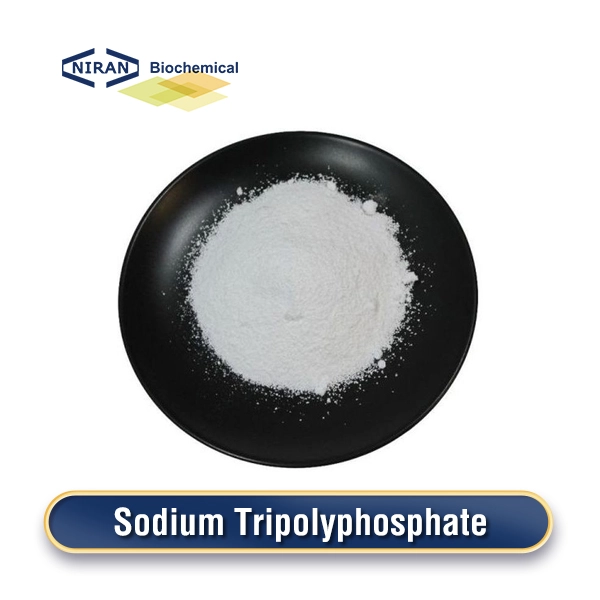Sodium tripolyphosphate (STPP), also called pentasodium triphosphate, is a high-volume inorganic phosphate used across detergents, food processing, ceramics, water treatment, textiles, and more. Its popularity comes from a rare combination of functions: it softens water, binds metal ions (sequestration/chelation), disperses solids, buffers pH, stabilizes proteins, and improves process efficiency. If you formulate cleaning products, optimize food texture and moisture, or deflocculate ceramic slurries, STPP is one of the most versatile building blocks you can choose.

What Is Sodium Tripolyphosphate?
- Chemical name: Sodium tripolyphosphate
- Synonyms: Pentasodium triphosphate, STPP, sodium triphosphate
- Molecular formula: Na₅P₃O₁₀
- Molar mass (anhydrous): ~367.86 g/mol
- CAS: 7758-29-4 (anhydrous), 15091-98-2 (hexahydrate)
- Appearance: White, free-flowing powder or granules; hygroscopic
- Odor: Odorless
- Taste: Slightly salty/alkaline
From a structural standpoint, STPP is the sodium salt of a linear triphosphate anion. It is produced as anhydrous and hydrated forms, and in two crystalline phases (often called Phase I and Phase II) that differ in dissolution behavior and densities. Commercial products are optimized for flowability, dissolution rate, low dusting, and stability.
Functionally, STPP is known as a builder in detergents (enhancing surfactant efficiency and soil removal), a sequestrant or chelating agent for hard-water ions (Ca²⁺, Mg²⁺), a dispersant for inorganic particles, a buffer, and a processing aid that stabilizes proteins and improves water retention in foods.
Key Properties and Specifications
Physicochemical Profile
| Property | Typical Value / Range | Notes |
| Chemical formula | Na₅P₃O₁₀ | Linear triphosphate |
| Molecular weight | ~367.86 g/mol | Anhydrous |
| Form | Powder or granules | Food/technical grades |
| Color | White | Free-flowing |
| Solubility in water | High (temperature-dependent) | Rapid dissolution is preferred in detergents |
| pH (1% solution) | ~9.0–10.2 | Mildly alkaline buffer |
| Bulk density | ~0.70–0.95 g/cm³ | Grade-dependent |
| True density | ~2.3–2.6 g/cm³ | Phase-dependent |
| Hygroscopicity | Moderate to high | Store dry, sealed |
| Thermal behavior | Decomposes at elevated T | Phase transitions; anhydrous stable in dry conditions |
Functional properties
- Sequestration/chelating: Binds Ca²⁺/Mg²⁺ to reduce water hardness and prevent scale/soap scum.
- Dispersion: Keeps particulate soils/clays suspended, avoiding redeposition.
- Buffering: Maintains alkaline pH helpful to detergency and some industrial processes.
- Protein interaction: In food, improves texture and water retention by stabilizing myofibrillar proteins.
- Electrolyte effect: Adjusts ionic strength for process stability (e.g., ceramics deflocculation).
Grades and Typical Specs
| Grade | STPP Assay (as Na₅P₃O₁₀) | Water Insolubles | Heavy Metals (as Pb) | Mesh/Particle Size | Typical Use |
| Technical | ≥ 94–96% | ≤ 0.1–0.2% | – | Powder 80–200 mesh; or granular | Detergents, ceramics, water treatment, textiles |
| Food (E451(i)) | ≥ 95–98% | ≤ 0.1% | Low (meets food regs) | Powder or granular; often low-dust | Food processing, seafood/meat/poultry moisture retention |
| Low-Iron / High-Purity | ≥ 96–98% | ≤ 0.05–0.1% | Very low | Custom | Toothpaste, high-end detergents, sensitive formulations |

How STPP Is Produced
Most industrial STPP is produced by neutralizing phosphoric acid with sodium carbonate or sodium hydroxide to obtain a controlled blend of disodium phosphate (Na₂HPO₄) and monosodium phosphate (NaH₂PO₄), then thermally condensing the salts to form the tripolyphosphate.
Simplified reaction (condensation):
2 Na₂HPO₄ + NaH₂PO₄ → Na₅P₃O₁₀ + 2 H₂O
Process highlights
- Raw materials: Phosphoric acid (wet-process or purified), sodium carbonate/sodium hydroxide, deionized water.
- Solution prep & neutralization: Precise pH and molar ratios control the Na/P balance and minimize by-products.
- Dehydration/condensation: Heating to high temperature (commonly 450–550 °C) in a rotary kiln or fluidized-bed reactor converts orthophosphates to tripolyphosphate.
- Phase control & quench: Cooling rate determines Phase I vs Phase II. Granulation and milling establish particle size distribution.
- Screening & finishing: De-dusting agents, flow aids, anti-caking treatments may be added depending on grade.
- Quality control: Assay (as Na₅P₃O₁₀), pH, bulk density, solubility, particle size, water insolubles, iron content, heavy metals (for food grade).
Environmental & quality notes
- Plants increasingly optimize kiln energy recovery, dust collection, and mother-liquor recycles.
- Food-grade production requires strict control of raw materials, filtration, and dedicated lines to prevent contamination.
Applications and How to Use STPP
Detergents & Cleaning Products (Laundry, Dish, Hard-Surface)
Role: STPP acts as a builder that softens water, enhances surfactant performance, disperses soils, and buffers alkaline pH. It inhibits scale and prevents redeposition of dirt onto fabrics/dishes.
Benefits in laundry/dish formulations
- Replaces multiple ingredients (softener + dispersant + buffer)
- Improves soil removal and whiteness retention
- Reduces need for high surfactant levels (cost/productivity lever)
- Synergistic with sodium carbonate, sodium silicate, zeolite A, enzymes, and oxygen bleach systems
Formulation tips
- Typical inclusion in legacy formulations ranged widely (e.g., 10–35% in powders), but detergent phosphate limits now apply in many consumer markets (see Regulations).
- Granular STPP offers excellent flow and dosing in high-speed packaging; powder provides faster dissolution.
- Control pH to avoid hydrolysis in very acidic systems; maintain dry storage to prevent caking.
Food Processing (E451(i))
Role: Food-grade STPP is a sequestrant, texturizer, and moisture retention agent. It stabilizes proteins and improves water-holding capacity in seafood, meat, and poultry, reducing drip loss and improving tenderness.
Common uses
- Seafood (shrimp, fish fillets): Reduce thaw/thermal drip, maintain firmness and color.
- Meat & poultry: Improve juiciness, slicing yield, and protein functionality in brines/marinades.
- Baked goods: Dough conditioning and ionic strength modification (with other phosphates).
- Dairy/processed cheese: Emulsifying salt systems (with other polyphosphates).
- Important: Maximum allowable use levels vary by product category and jurisdiction. Always verify local regulations and labeling requirements (e.g., Code of Federal Regulations,
- EU additives catalog (Codex). In many applications, usage is fractions of a percent of finished product weight, often in combination with other phosphates (e.g., sodium hexametaphosphate, tetrasodium pyrophosphate).
Practical advice
- Dissolve STPP completely in cold or cool water before mixing with proteins to avoid localized high pH.
- Combine with sodium bicarbonate or citrate in some meat systems to balance pH and taste.
- Manage ionic strength to target texture without excessive firmness.
Water Treatment
In boiler water and cooling systems, STPP helps sequester calcium/magnesium, improving scale control and dispersing iron oxides. It also buffers pH in mildly alkaline ranges. Use with caution: in uncontrolled environments, phosphates can become nutrients; effluent treatment must address phosphorus discharge limits.
Ceramics and Clay Processing
STPP is a classic deflocculant: it reduces slurry viscosity at a given solids loading, enabling higher solids content, improved casting rate, fewer defects, and smoother finishes. Pairing with sodium silicate lets you fine-tune zeta potential and rheology for slip casting and glazing.
Textiles, Leather, and Pulp & Paper
- Textiles: Aids scouring and dyeing by removing hardness ions and improving wet-processing uniformity.
- Leather: Enhances wetting and dispersion in tanning/retanning steps.
- Pulp & paper: Acts as a dispersant and water conditioner in certain process stages.
Oil & Gas / Drilling Muds
In water-based muds, STPP can help disperse clays, control rheology, and mitigate hardness interference, contributing to more stable mud properties.
Oral Care and Home Care
In toothpastes, low-iron/high-purity STPP contributes to tartar control and acts as a polishing aid and buffer, often in combination with silica abrasives and fluoride systems. In hard-surface cleaners, STPP helps prevent film/spotting by binding hardness ions and keeping soils dispersed.
Advantages of STPP (Why Formulators Choose It)
- Multifunctionality: One ingredient delivers water softening, sequestration, dispersion, and buffering—simplifies formulations and inventory.
- Performance: Enhances surfactant efficiency and soil removal, stabilizes proteins, reduces redeposition and scaling.
- Processability: Available in flowable granules or fine powders; dissolves well and is compatible with many systems.
- Cost-effectiveness: Historically cost-competitive versus multi-ingredient systems delivering similar functions.
- Proven track record: Decades of industrial and food-processing use with mature quality specs and supply chains.
Environmental Impact and Sustainability
Phosphorus and eutrophication: STPP itself is not considered hazardous at typical use concentrations, but phosphorus is a nutrient that can drive algal blooms in sensitive waters. Consequently, many jurisdictions limit phosphate content in consumer detergents to reduce phosphorus loads from domestic wastewater.
Wastewater treatment considerations
Advanced plants remove phosphorus via biological nutrient removal (BNR) and/or chemical precipitation (e.g., alum, ferric salts).
Industrial users should confirm discharge permits and, if necessary, implement pretreatment or chemical precipitation to meet total phosphorus limits.
Alternatives and partial replacements
Zeolites (A, P) for hardness control (often with co-builders like sodium citrate, sodium carbonate, polycarboxylates).
Biodegradable chelants like GLDA or MGDA in premium/lower-phosphate or phosphate-free systems.
Citric acid, sodium gluconate, sodium silicate for buffering/dispersion roles.
Sustainability in production
Modern plants emphasize energy efficiency (heat recovery in kilns), dust capture, and recycling of process waters/solids to reduce environmental footprint.
Regulations, Standards, and Labeling
Detergent phosphates
- Many regions restrict or ban phosphates in household laundry and automatic dishwashing detergents, particularly for consumer markets.
- Industrial/institutional (I&I) uses may have different allowances. Always verify local detergent regulations before formulating or selling.
Food additive status
STPP is typically listed as E451(i) in the EU and recognized in numerous jurisdictions as a food additive for specific functions and foods, each with maximum use levels and labeling requirements.
Compliance frameworks include EU food additive regulations, Codex Alimentarius, and national standards (e.g., GB in China, CFR in the United States). Requirements vary by product (fish/seafood, meat/poultry, cheese, bakery, etc.).
Standards & quality systems
Suppliers often certify against ISO 9001, FSSC 22000 or equivalent for food grade, and provide COAs detailing assay, pH, insolubles, heavy metals, moisture, and particle size.
Action point: For any market, confirm the latest regional regulations and standards (detergent and food) and align your COA, labeling, and SDS accordingly.
Formulation & Processing Know-How
Detergents (Powder and Tablets)
- Builders system: If regulations limit STPP, consider hybrid systems: zeolite A + small STPP + citrate/carbonate + polymeric dispersants.
- Dissolution: Choose particle size to balance low dust (granular) with fast dissolution (finer).
- pH control: Target alkaline pH (~9–10 in use) for surfactant efficiency; support enzymes with suitable stabilizers.
- Compatibility: STPP is compatible with anionic/nonionic surfactants, oxygen bleaches, and silicates; manage ionic strength to maintain enzyme performance.
Food Brines and Marinades
- Order of addition: Dissolve STPP thoroughly in water first; then add other salts (e.g., NaCl, citrate), sweeteners, flavors, and finally incorporate with protein.
- Dosage: Use the minimum effective level to achieve target yield/texture; adhere to legal maxima.
- Synergies: STPP + sodium hexametaphosphate (SHMP) can modulate ionic strength and protein solubility; fine-tune for sensory quality.
Ceramics & Clay Systems
- Deflocculation strategy: Start with bench tests at ppm–low-thousands ppm STPP relative to solids; measure viscosity and casting rate.
- Co-additives: Combine with sodium silicate; adjust ratios to reach minimum Brookfield viscosity at target solids.
Quality Control, Testing, and Typical COA Items
Incoming material tests
- Assay (as Na₅P₃O₁₀) by titration or ion chromatography
- pH (1% solution)
- Moisture (loss on drying)
- Water insolubles
- Iron (and other trace metals), particularly for food and oral-care grades
- Particle size distribution (sieving/laser diffraction)
- Bulk density & flowability
- Whiteness/appearance and dissolution rate
Example COA snapshot (illustrative)
| Parameter | Result | Method |
| Assay (as Na₅P₃O₁₀) | 96.5% | Titration |
| pH (1% soln, 25 °C) | 9.7 | pH meter |
| Moisture | 0.4% | Oven, 105 °C |
| Water insolubles | 0.05% | Gravimetric |
| Fe (as Fe) | 20 ppm | ICP-OES |
| Particle size (pass 100 mesh) | 95% | Sieve |
| Bulk density | 0.84 g/cm³ | Tapped |
Sourcing, Pricing Drivers, and Logistics
Pricing drivers
- Phosphoric acid and soda ash/caustic costs
- Energy intensity of thermal condensation and phase control
- Purity/grade (food vs technical; low-iron specifications)
- Particle engineering (granulation, anti-caking)
- Packaging (bag vs big-bag) and logistics
Supplier selection checklist
- Proven regulatory compliance (detergent phosphate rules, food additive approvals)
- Consistent assay and low insolubles
- Low heavy metals for food/oral-care
- Phase/particle control for your process (fast dissolve vs low dust)
- Robust SDS/COA and traceability
- Capacity and lead times aligned to your demand profile
- Technical support for formulation optimization
Logistics
- Ship in lined bags/big-bags on pallets; protect from moisture.
- For food grade, consider dedicated pallets and clean trailers/containers; document temperature/humidity excursions if relevant.
Sodium tripolyphosphate remains a cornerstone functional additive thanks to its unmatched combination of water softening, sequestration, dispersion, buffering, and—in foods—protein stabilization and moisture retention. While environmental policies have reduced phosphate usage in certain consumer detergents, STPP continues to deliver essential value in I&I cleaning, food processing, ceramics, textiles, water treatment, and oral care.
Looking ahead, expect:
- Continued regulatory differentiation between consumer and industrial uses.
- Growing demand for phase-engineered and high-purity grades.
- More hybrid systems, where STPP is combined with zeolites or biodegradable chelants to balance performance, cost, and sustainability.
If you need help translating this guide into spec sheets, COA templates, or detergent/food/ceramic formulations (with suggested starting dosages aligned to your application and local regulations), tell me your target market and performance goals—I’ll tailor a working recipe and QC checklist for you.
